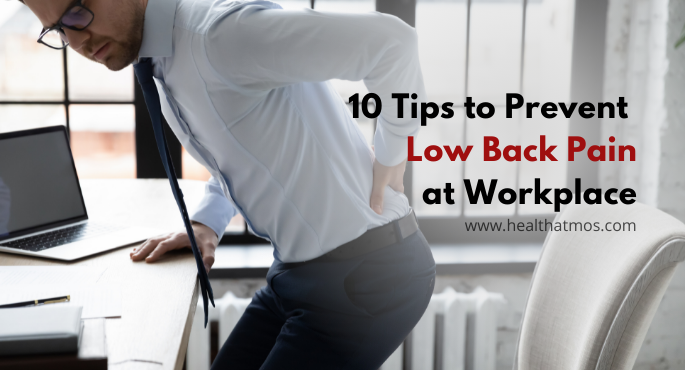How to Prevent Low Back Pain at the Workplace?
Heavy lifting, repetitive movements and sitting for long hours at your desk will take a toll on your back. Back pain makes it difficult to concentrate on your job. This article will give you tips that can prevent low back pain at the workplace.
1. Maintain Good Posture
Poor sitting posture is a major reason for causing lower back pain. Be sure to maintain a good posture both at the office and at home. Make sure to divide long periods in front of the computer with stretching exercises. If you practice good posture, you can maintain the natural curve of your back. Sitting with your back straight and knees bent at 90 degrees angle takes off the pressure on the nerves and lowers back pain.
2. Support Your Back
Choose a good quality ergonomical chair that provides firm support for your lower back. A cushioned backrest will prevent slouching and aid in lower back pain relief. Make sure that your knees are a right angle to your feet placed straight on ground or foot stool.
3. Stretch
Continuous standing, sitting, or lying down in one place is not healthy for your back. Whenever possible relieve the strain by getting up, walking around, and doing some simple stretches. This will help to improve circulation to your back. It will also ease aches or strains that occur due to inactivity.
4. Don’t Cross Your Legs
Sitting cross-legged will strain your pelvic muscles, and makes it difficult to keep your spinal cord straight. This increases the risk of lower back pain, so you must uncross your legs and relax.
5. Proper Foot Rest
If you have to raise your feet above the ground, you should use a foot-stool to rest your feet comfortably. This will relieve pressure and relax foot and calf muscles, thereby causing less strain on your back.
6. Change your footwear
Wear comfortable, low-heeled shoes to prevent back pain. They will reduce strain on your back while standing. Shoes with less than a 1-inch heel are recommended.
7. Increase your calcium and vitamin D intake
Strong bones can help prevent Osteoporosis, which is one of the most common causes of back pain later in life, particularly for women.
8. Regular Exercise
Exercise is the best way to prevent lower back pain. Choose your exercise and stick to it. You can consider walking, cycling, swimming, yoga, or deep breathing exercises; but do it every day. These can help to prevent lower back pain.
9. Lighten your load
Carrying a bulky laptop bag, suitcase, camera, or a load of groceries can also cause strain on your back. Whenever possible, take the weight off your shoulders by carrying less and balance the weight to both sides of your body, or shifting the weight from one shoulder to another shoulder. You can also consider using a rolling cart or bag with wheels for heavier loads.
10. Quit Smoking
Smoking is a serious health risk, and smokers will experience back pain more than non-smokers. The reason for this is that nicotine restricts blood flow to the disc in the spine, which can cause it to dry out, crack, or rupture. Smoking also reduces the amount of oxygen in the blood, which causes a reduction in nourishment to the muscles and tendons of the back. An unhealthy, weak back is vulnerable to accidental strains and pulls which cause back pain.
You can reduce your risk for back pain by adjusting lifestyle changes. However, if you should experience back pain, do not ignore it. As it could be a sign of a more serious condition. Therefore, we recommend you to enroll for a corporate health checkup package with Health Atmos.
Employers can get in touch with our healthcare experts to know more about Employee Health Checkup package and Corporate Health Checkup package at exclusive rates.

